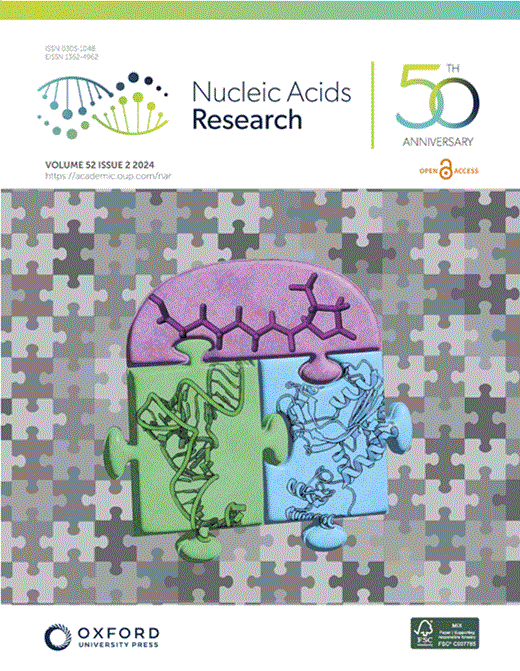Mgv1-Rlm1轴在目标启动子处协调SAGA和SWI/SNF复合物
IF 16.6
2区 生物学
Q1 BIOCHEMISTRY & MOLECULAR BIOLOGY
引用次数: 0
摘要
SWI/蔗糖不可发酵(SWI/SNF)促进核小体的去除和Spt-Ada-Gcn5乙酰转移酶(SAGA)复合物介导的组蛋白乙酰化对转录起始的激活至关重要。然而,在植物病原真菌感染过程中,这两种复合物如何协调调节参与细胞壁重塑的基因表达或响应外部刺激的机制在很大程度上仍然未知。在这里,我们证明了在毒素(脱氧雪腐镰刀菌醇)诱导条件下,植物病原真菌镰刀菌的细胞壁完整性(CWI)途径被激活。这种处理导致有丝分裂原激活蛋白激酶FgMgv1在CWI信号通路中的磷酸化和核易位。一旦进入细胞核,激活的FgMgv1磷酸化下游转录因子FgRlm1, FgRlm1与靶基因启动子中的12-或14-bp顺式元件结合。值得注意的是,FgMgv1形成聚合物,并通过其激酶结构域与FgRlm1相互作用。至关重要的是,这种聚合使FgMgv1能够通过其靶启动子上的c端结构域同时招募SWI/SNF和SAGA复合物。FgMgv1、FgRlm1、SWI/SNF和SAGA之间的这种协同作用最终促进了靶基因的转录激活。总的来说,这些发现阐明了一个调控框架,其中Mgv1-Rlm1轴作为一个关键的调控枢纽,将CWI信号与表观遗传修饰结合起来,以确保转录对外部刺激的反应。本文章由计算机程序翻译,如有差异,请以英文原文为准。
The Mgv1–Rlm1 axis orchestrates SAGA and SWI/SNF complexes at target promoters
The SWI/sucrose non-fermentable (SWI/SNF)-facilitated removal of nucleosomes and Spt-Ada-Gcn5 acetyltransferase (SAGA) complex-mediated histone acetylation are crucial for the activation of transcription initiation. However, the mechanism by which these two complexes coordinate to regulate gene expression involved in cell wall remodeling during infection process or in response to external stimuli remains largely unknown in plant pathogenic fungi. Here, we demonstrate that the cell wall integrity (CWI) pathway is activated under toxin (deoxynivalenol)-inducing conditions in the phytopathogenic fungus Fusarium graminearum. This treatment results in the phosphorylation and nuclear translocation of the mitogen-activated protein kinase FgMgv1 in the CWI signaling pathway. Once in the nucleus, the activated FgMgv1 phosphorylates the downstream transcription factor FgRlm1, which binds to a 12- or 14-bp cis-element in the promoters of target genes. Notably, FgMgv1 forms a polymer and interacts with FgRlm1 via its kinase domain. Crucially, this polymerization enables FgMgv1 to recruit both the SWI/SNF and SAGA complexes simultaneously through its C-terminal domain at the target promoters. This coordinated action among FgMgv1, FgRlm1, SWI/SNF, and SAGA ultimately facilitates the transcriptional activation of target genes. Collectively, these findings illuminate a regulatory framework in which Mgv1–Rlm1 axis serves as a key regulatory hub, integrating CWI signals with epigenetic modifications to ensure transcriptional responsiveness to external stimuli.
求助全文
通过发布文献求助,成功后即可免费获取论文全文。
去求助
来源期刊

Nucleic Acids Research
生物-生化与分子生物学
CiteScore
27.10
自引率
4.70%
发文量
1057
审稿时长
2 months
期刊介绍:
Nucleic Acids Research (NAR) is a scientific journal that publishes research on various aspects of nucleic acids and proteins involved in nucleic acid metabolism and interactions. It covers areas such as chemistry and synthetic biology, computational biology, gene regulation, chromatin and epigenetics, genome integrity, repair and replication, genomics, molecular biology, nucleic acid enzymes, RNA, and structural biology. The journal also includes a Survey and Summary section for brief reviews. Additionally, each year, the first issue is dedicated to biological databases, and an issue in July focuses on web-based software resources for the biological community. Nucleic Acids Research is indexed by several services including Abstracts on Hygiene and Communicable Diseases, Animal Breeding Abstracts, Agricultural Engineering Abstracts, Agbiotech News and Information, BIOSIS Previews, CAB Abstracts, and EMBASE.
 求助内容:
求助内容: 应助结果提醒方式:
应助结果提醒方式:


